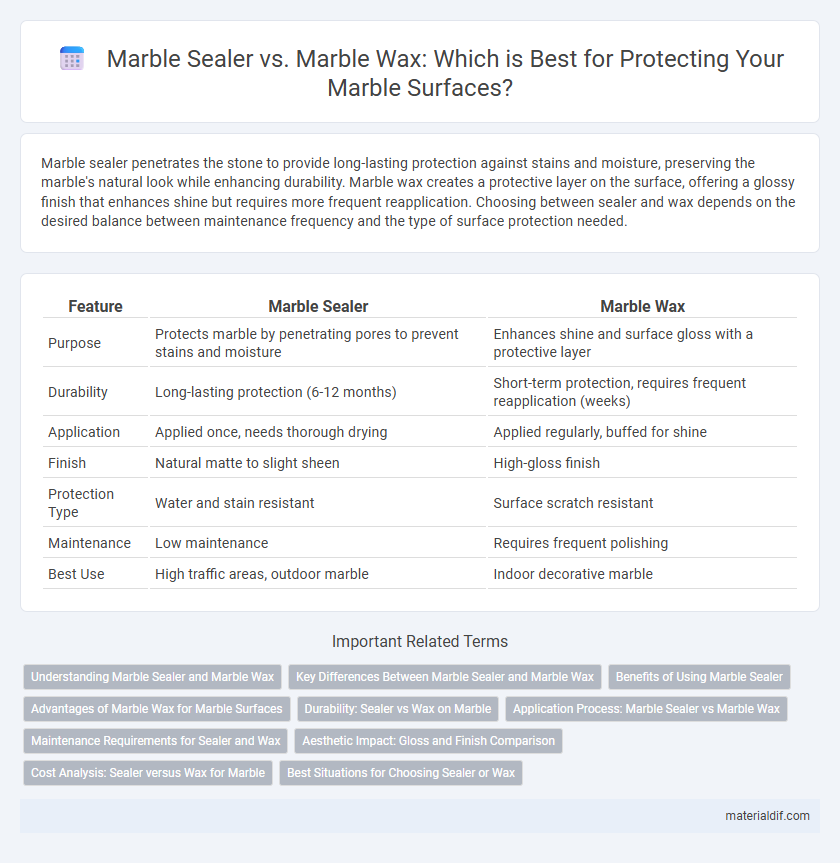Marble sealer penetrates the stone to provide long-lasting protection against stains and moisture, preserving the marble's natural look while enhancing durability. Marble wax creates a protective layer on the surface, offering a glossy finish that enhances shine but requires more frequent reapplication. Choosing between sealer and wax depends on the desired balance between maintenance frequency and the type of surface protection needed.
Table of Comparison
| Feature | Marble Sealer | Marble Wax |
|---|---|---|
| Purpose | Protects marble by penetrating pores to prevent stains and moisture | Enhances shine and surface gloss with a protective layer |
| Durability | Long-lasting protection (6-12 months) | Short-term protection, requires frequent reapplication (weeks) |
| Application | Applied once, needs thorough drying | Applied regularly, buffed for shine |
| Finish | Natural matte to slight sheen | High-gloss finish |
| Protection Type | Water and stain resistant | Surface scratch resistant |
| Maintenance | Low maintenance | Requires frequent polishing |
| Best Use | High traffic areas, outdoor marble | Indoor decorative marble |
Understanding Marble Sealer and Marble Wax
Marble sealer penetrates the stone's porous surface to create a protective barrier that resists stains and moisture, preserving the marble's natural appearance and durability. Marble wax, on the other hand, forms a surface layer that enhances shine and offers temporary protection against scratches and spills, but requires frequent reapplication. Choosing between marble sealer and marble wax depends on the level of protection needed and the aesthetic finish desired for marble countertops or floors.
Key Differences Between Marble Sealer and Marble Wax
Marble sealer penetrates the stone's pores to create a protective barrier against stains and moisture, maintaining the marble's natural appearance while enhancing durability. Marble wax sits on the surface, providing a glossy finish and temporary protection but requires frequent reapplication due to its less durable nature. Sealers are ideal for long-term protection, whereas waxes are primarily used for aesthetic enhancement and occasional maintenance.
Benefits of Using Marble Sealer
Marble sealer provides long-lasting protection by penetrating the stone's pores to prevent stains, moisture, and damage from acidic substances. It enhances the natural beauty of marble while maintaining breathability, which helps to preserve the stone's integrity and extend its lifespan. Unlike wax, marble sealer requires less frequent application and offers superior resistance against etching and discoloration.
Advantages of Marble Wax for Marble Surfaces
Marble wax enhances the natural sheen and provides a protective barrier that repels water, stains, and dirt, making it ideal for maintaining the aesthetic appeal of marble surfaces. It offers easy application and quick drying time, allowing for regular use without extensive downtime. Marble wax also nourishes the stone, preserving its color and preventing dullness or etching caused by acidic substances.
Durability: Sealer vs Wax on Marble
Marble sealer provides long-lasting protection by penetrating the stone's surface, creating a durable barrier against stains and moisture that can last up to one year or more with proper maintenance. In contrast, marble wax forms a surface-level coating that enhances shine but typically requires reapplication every few months due to its tendency to wear off faster under foot traffic and regular cleaning. Choosing a sealer over wax offers superior durability for high-traffic areas and effective preservation of marble's natural appearance.
Application Process: Marble Sealer vs Marble Wax
Marble sealer penetrates the stone's pores to create a protective barrier against moisture and stains, requiring a clean, dry surface and typically multiple coats with adequate drying time between applications. Marble wax, applied as a paste or liquid, sits on the surface forming a thin protective layer that enhances shine but requires buffing and periodic reapplication to maintain its effect. The sealer's application demands careful timing and ventilation, whereas wax application is more straightforward but less durable against wear and environmental factors.
Maintenance Requirements for Sealer and Wax
Marble sealer requires reapplication every 1 to 3 years depending on foot traffic and exposure to liquids, providing a protective barrier that penetrates the stone to prevent stains and moisture absorption. Marble wax demands more frequent maintenance, often every few months, as it sits on the surface and wears away with regular use, requiring buffing to restore its shine and protective qualities. Choosing between sealer and wax depends on the level of durability and upkeep desired, with sealers offering longer-lasting protection and wax providing enhanced surface gloss but higher maintenance frequency.
Aesthetic Impact: Gloss and Finish Comparison
Marble sealer enhances the stone's natural color while providing a subtle, matte or satin finish that emphasizes its elegant texture. Marble wax imparts a high-gloss shine that intensifies the surface's brightness and depth, creating a polished, reflective look. Choosing between sealer and wax depends on the desired aesthetic impact, with sealers preserving a natural tone and waxes offering a lustrous, mirror-like finish.
Cost Analysis: Sealer versus Wax for Marble
Marble sealers typically cost between $30 and $50 per gallon, offering long-lasting protection that can last up to one year, making them a cost-effective option for preserving marble surfaces. Marble wax is generally priced lower, around $15 to $30 per container, but requires more frequent application, often every few months, leading to higher maintenance expenses over time. When analyzing cost, sealers provide better value for heavy-use areas due to their durability, while wax may be preferable for decorative marble with lighter wear.
Best Situations for Choosing Sealer or Wax
Marble sealer is best suited for high-traffic areas and surfaces exposed to liquids, providing long-lasting protection against stains and etching by penetrating the stone's pores. Marble wax offers a natural shine and surface-level protection ideal for decorative pieces or low-use areas, enhancing the marble's appearance without deep absorption. Choosing a sealer is optimal for durability and maintenance, while wax suits those prioritizing aesthetic enhancement and softer, periodic care.
Marble Sealer vs Marble Wax Infographic

 materialdif.com
materialdif.com